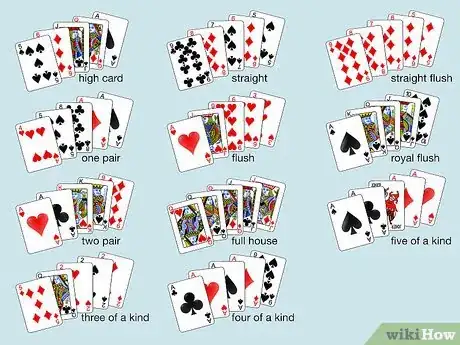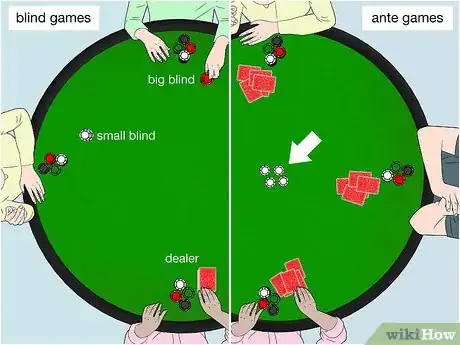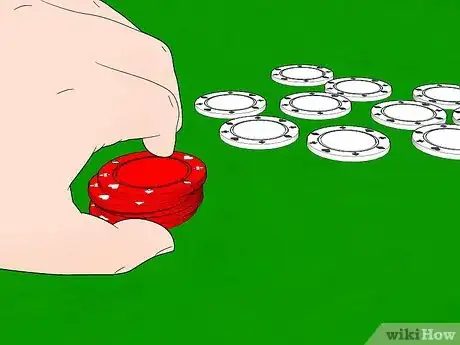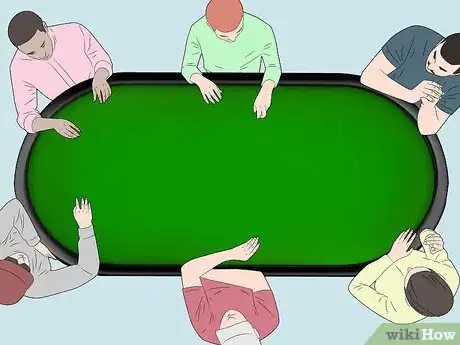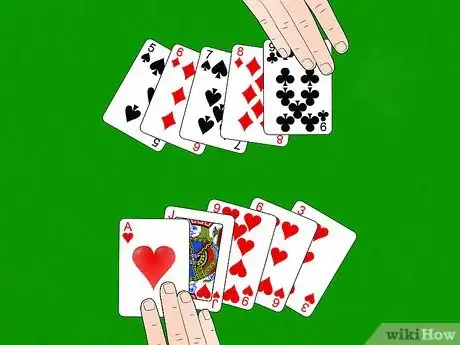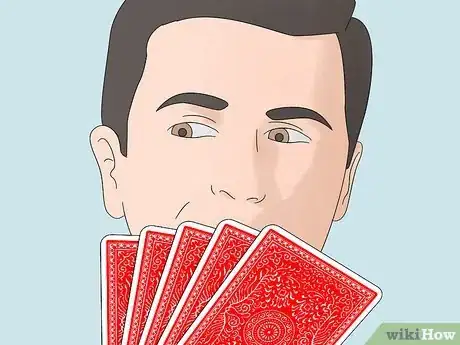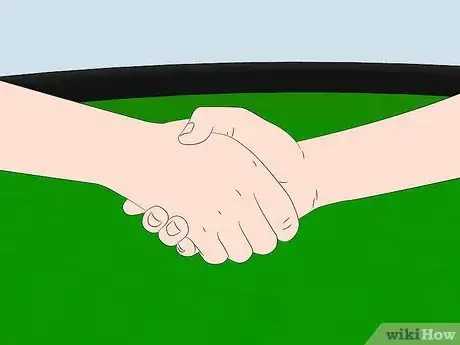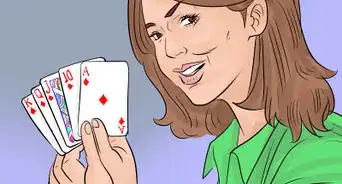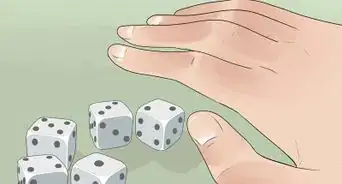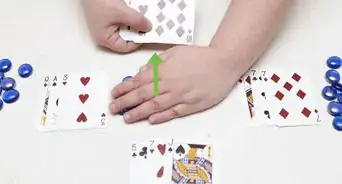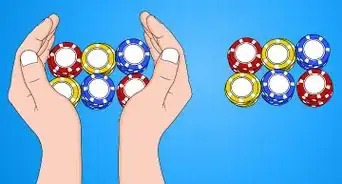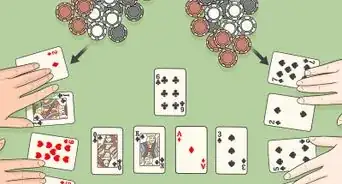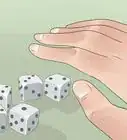wikiHow is a “wiki,” similar to Wikipedia, which means that many of our articles are co-written by multiple authors. To create this article, 16 people, some anonymous, worked to edit and improve it over time.
There are 7 references cited in this article, which can be found at the bottom of the page.
wikiHow marks an article as reader-approved once it receives enough positive feedback. In this case, 93% of readers who voted found the article helpful, earning it our reader-approved status.
This article has been viewed 124,442 times.
Learn more...
Five-card Draw is one of the most classic poker games there is. Until the rise of Texas Hold 'Em, it dominated the betting scene. It's similar, but takes on a very different twist. In this guide, we'll talk about the basics, the not-so-basics, and etiquette and strategy. So grab your poker chips, your potato chips, and crack open your wallet. You ready to play?
Things You Should Know
- Play 5-card draw with 6 people and decide on your game variations.
- Establish your blinds or antes, deal 5 cards to each player, then bet.
- Draw new cards to replace the ones you don't want to keep, then fold or bet again.
- Win the pot if everyone else folds or if you have the best hand.
Steps
Rules
-
1Memorize the hand ranks. If you're completely new to the poker scene, you have to know the ranking of the hands before anything else. If you don't, you could have a winning hand and not even realize it! So before we tackle anything specific to 5-card, let's establish the hierarchy of hands, starting with the lowest:
- High card (aka a big fat nothing)
- One pair
- Two pair
- Three of a kind
- Straight
- Flush
- Full house
- Four of a Kind
- Straight Flush
- Royal Flush
- Five of a kind (if playing with a wild card)
-
2Know the gist. So now that you know the hands, how do you play the actual game? Well, for starters, you're trying to make the highest-ranked hand. Here are the basics, and we'll get to specifics in the next section (Setting Up the Game):
- The dealer deals everyone 5 cards
- Initial bets are placed
- Players request new cards, throwing away a portion of their old cards, forming the best hand possible
- Another round of bets takes place
- Players still standing show their cards
- The player with the best hand takes the pot
Advertisement -
3Understand the difference between blind and ante games. 5-card has two possible variants when it comes to beginning any round: blind or ante. It's all a matter of personal preference -- or how your friends feel!
- In blind games, the person to the left of the dealer is the "small blind." They put up a bet (usually incredibly small and always half of the big blind) before any hands are dealt. The person to left of the small blind is the "big blind" -- they, too, put in a bet before any hands are dealt, though their bet is twice the small blind. Anyone who wants to play the round (after the hands are dealt) has to match the big blind to play.
- In ante games, everyone has to put a predetermined amount into the pot in order to be dealt any cards. It discourages folding, at least initially.
-
4Know how to check, call, raise, and fold. After the dealer has dealt you your five cards and the betting rolls around to you, you have three options: to call, raise, or fold. Everyone has their own strategy as to how to go about this, but here's what they are:
- Checking is basically betting 0. If no bets have been placed, you can check. But the second someone places a bet, you then must call, raise, or fold.
- Calling is when you match the bet that's on the table. If everyone has put 10 cents into the pot to play, you put 10 cents into the pot to play.
- "Raising" is when you increase the amount of money in the pot. If the player to your left put in 10 cents and you put in 15, you have raised the bet 5. Players must then match your bet (call) to stay in play.
- Folding is when you want out. You throw your cards face down on the table and you're finished for that round, no money won, some lost.
-
5Consider wild cards. 5-card is a very fun game, but an extra element of surprise and strategy comes into play when you introduce wild cards. Just make sure everyone agrees on this (and what it is) beforehand. This makes the "5 of a kind" a potential hand -- and the best one at that.
- Some play deuces wild (2s), while others will take the first card off the deck (after the deal) and play with the remaining three as wild. Still others play with the one-eyed Jack or or a joker inserted into the deck (playing with 53 cards).
- If you do play with a wild card, decide if there are any restrictions on it; this is known as a "bug." A joker inserted into the deck may only be able to represent an Ace or to finish a straight or flush; it cannot be any random number a player picks.
-
6Work with limits. More variations! If you want to exercise some control over the amount of money flowing over the table, you'll incorporate some kind of limit into your game. But you don't have to! It can prevent players from running out of (and thus losing) money, a big spender bullying the others, and things getting out of hand. Again, three options:
- No limit. Pretty self-explanatory.
- Limit. You decide what the minimum and maximum bets are -- and these can be different in the initial and second betting rounds.
- Pot limit. No bet may be greater than what's already in the pot.
-
7Talk about playing lowball. Sometimes everyone's hands suck. In that situation, playing lowball is an option -- where you try to get the lowest hand possible. So if and when everyone's gone around the table and no one wants in or everyone is checking, switching to lowball is an option.
- In this variation, generally Aces switch to low (normally, they're high) and straights and flushes don't count. So the worst possible hand you could have would be A-2-3-4-5.[1] You have no pairs and 5 is your highest card. Womp womp.
Setup
-
1Grab a handful of friends. 5-card is best played with around 6 people, though 4-8 is good, too, and you could fudge 3 if you absolutely had to. Clear off your dining room table, grab a bowl of chips, and set everyone down. They all know how to play, right?
- If they don't, show them this page and put them in the corner for 5 minutes. Or let them play cluelessly and take their money before they even realize it!
-
2Get something to bet with. If you don't have actual poker chips laying around, you'll need things to bet with and to assign them a correlating value. Anything small that you have a lot of will do just fine. Paperclips? Those are worth 5. And the peanuts? 10. Just make sure you don't eat them absent-mindedly.
- It's a good idea to have denominations of 50, 25, 10, 5, and 1, though ultimately it's up to you. Do you wanna bet $1000 at a time? Go ahead -- just make sure everyone has the chump change to back it up. And if you are making sure everyone fulfills their bets, state explicitly that 1 is 1 cent or 1 dollar! That makes a bit of a difference.
-
3Do your blind or ante. You read that first section, right? Well, do you want to start your game with a blind or an ante? It's all just about the same amount of money in the end. It's just easier to cop out in a blind!
- If you do choose blind, be sure to rotate it with each round. The dealer, small blind, and big blind should move one space to the left with each deal. So the small blind becomes the dealer, the big blind becomes the small blind, and the next guy to the left becomes the big blind. Capisce?
-
4Have the dealer shuffle and cut the deck and then deal to their left. Shuffle that deck up well! No stacking it. And then have the dealer hand the deck to the player on their right to cut it. They then deal the deck, 5 to a player, starting with the player on the left.
- Who's the dealer? Good question. You could either do it voluntarily, by age, or by a simple, quick who's-got-the-highest-card before play begins.
-
5Initiate the first round of betting. Alright, so either your blinds or your antes are established, the first round of cards is dealt, and betting commences. If you're playing blind, begin with the player to the left of the blinds. If you're playing ante, begin with the player to the left of the dealer.
- Let's say there's players A, B, C, and D. Player A (the one to the left of the dealer) checks. B could check (betting 0), but he bets 5. C then has to either bet 5 (or more), or fold; he folds. D then calls, also betting 5. It comes back to A -- he never put any money in -- who has to call, raise, or fold. He calls.
-
6Start the draw round. Now that everyone has either bet or folded, the draw round starts. The players give the dealer the cards they don't want in exchange for the same amount of new cards in return; the hand is still (and always) comprised of 5 cards. The dealer starts with the player to his left, as usual.
- In some variations, only 3 cards can be tossed away. In some 4, if you have an ace. And in others, all 5 can be thrown in. It's up to you and your friends which variant you want to play.
-
7Initiate the second round of betting. Now that everyone has their semi-new hands, betting begins again, starting with the same person as last time. It's the same protocol, only generally the stakes are higher. Let's take our same example from before:
- If you recall, C has folded and everyone else is in. A puts in 5, B puts in 5, and D puts in 10. A folds, and B "sees" his 10 (putting in 5 more) and raises 15 (20 in total). D calls, putting in 15 more.
-
8Begin the showdown! When it's down to two players, it's showdown time. The player who played the last big move (in this case, B) generally exposes his hand first. The second player lays his cards down, too, and the winner sweeps up the pot.
- The second player can choose to never turn his face cards up if he admits defeat verbally. This can add an element of mystery and strategy -- was he just bluffing the entire time? No one will know.
Strategy and Etiquette
-
1Never reveal your cards, even if you've folded. This is just general poker guideline #1 -- don't do it. If you do reveal your cards, the other players can start to deduce when you fold (and thus when you don't) and what other cards are likely on the table. It can be distracting, too! So just don't do it. It's in your best interest, after all.
- Really, just don't reveal anything you don't have to. This game is just as much about psychology as it is about luck and strategy! Which brings up the next point.
-
2Practice your poker face. Those guys aren't wearing their sunglasses inside just to channel Corey Hart.[2] Keep your face and body unreadable if you can help it. Or fake 'em out, whichever. The people across from you are probably trying to figure out your playing style -- so make it as difficult for them as possible.
- It's best to just not be ruffled by anything. If you have a good hand, so be it. If you have a bad hand, so be it. If you have an incredibly mediocre hand, so be it. There's no room for feelings in poker, kid.
-
3Change up how you bet and draw. It's not uncommon for a newbie poker player to win, partly based on the fact that they don't know what they're doing and haven't developed a tried-and-true strategy; they kind of just go by the seat of their pants. Because of this, their opponents have no idea what to expect. So switch up how you attack the game in two ways: how you bet and how you draw.
- The betting is pretty straight-foward. Sometimes bet when you have a terrible hand, sometimes don't. Sometimes do outrageous raises, sometimes fold all too easily. Sometimes raise when you can call, sometimes call when you probably should've raised, etc. There's infinite possibilities.
- The number of cards you draw is actually pretty telling. If you draw one, your opponents probably think you have two pair or you're gunning for a flush or a straight. So even if you'd think about drawing two, this could be a strategy. Or vice versa!
-
4Don't hem and haw too much. You can hem and haw a little when placing your bets -- everyone needs a minute once in a while to wrap their brain around the game -- but don't waste everyone's time with each round. The game is a lot more exciting when it keeps going. If you don't have a goldfish's clue as to what to do after a minute, just go for it. It's called the learning process.
-
5Be polite. Poker players take their game very seriously. Have you ever walked into a poker tournament and started making noise? You'll be escorted out faster than you can fold 'em. So be polite. Don't cause a stir, be purposefully distracting or obnoxious, and keep to yourself. People are trying to make money here.
- In general, be quiet when you're out. If you've folded, you have no business getting in on the mix. Just watch, have fun observing, and let the hand play out. You'll learn more from watching than you will any other way.
- Don't splash into the pot. If you're making a big bet, don't throw your money into the pot; it becomes much, much harder to count that way. Instead, put it in in stacks of 5 or 10. It keeps things clean and simple.
- Be a gracious winner and loser. Attitudes can easily ruin this game, so don't do it. If you mopped the floor with them, don't rub it in their faces. And if you were the mop, kindly demand a rematch. Same time next week?
Community Q&A
-
QuestionWhat do you do if someone can't call a bet because they don't have enough chips?
 Community AnswerIf they want to stay in and not fold they would go "all in" with what they have but keep their chips separate from the main pot. Their chips then would be matched from the main pot if they win or taken by the winner.
Community AnswerIf they want to stay in and not fold they would go "all in" with what they have but keep their chips separate from the main pot. Their chips then would be matched from the main pot if they win or taken by the winner.
wikiHow Video: How to Play Five Card Draw
Warnings
- You can lose a lot of money in this game. Be careful and don't get in over your head.⧼thumbs_response⧽
References
- ↑ http://www.pagat.com/poker/variants/5draw.html
- ↑ http://www.youtube.com/watch?v=X2LTL8KgKv8
- http://www.pokerlistings.com/poker-rules-5-card-draw
- http://www.pokerlistings.com/poker-hand-ranking
- http://www.pagat.com/poker/variants/5draw.html
- http://www.contrib.andrew.cmu.edu/~gc00/reviews/pokerrules
- http://www.pokerology.com/lessons/five-card-draw/
About This Article
Five-Card Draw is a classic poker game where players try to create the best 5-card poker hand. To play, first each player puts a predetermined ante into the pot, like 10 dollars. Then, the dealer deals everyone 5 cards face down, one at a time. Each player looks at their hand, and the player to the left of the dealer, player 1, can either check (bet nothing) or bet by putting money or chips into the pot. Then, the player to their left, player 2, can do one of four things: check (unless player 1 bet, in which case player 2 must bet to stay in that round), call (match the bet in the pot), raise (bet more than the player before them), or fold (forfeit that round). If player 2 calls, the bet stays the same, and player 3 then must either call, raise, or fold. Alternatively, if player 2 raises, then the bet increases for each subsequent player, and player 1 must add the difference between their initial bet and the raised bet to the pot. Once every player has checked, called, raised, or folded, each player can give up to 3 cards from their hand to the dealer in exchange for new face-down cards from the deck. If a player has an ace in their hand, they can exchange up to 4 cards instead. Players don’t have to exchange any cards if they’d like to keep all of the cards in their hand. Once every player, including the dealer, has exchanged any cards they’d like to, another round of betting begins, starting with the player to the left of the dealer. Once everyone is finished betting, each player still in the round reveals their hand. The player with the highest hand wins the pot. In order from lowest to highest, the cards are ranked: high card, one pair, two pair, three of a kind, straight, flush, full house, four of a kind, straight flush, royal flush. For tips on how to place bets if you don’t have poker chips, read on!
